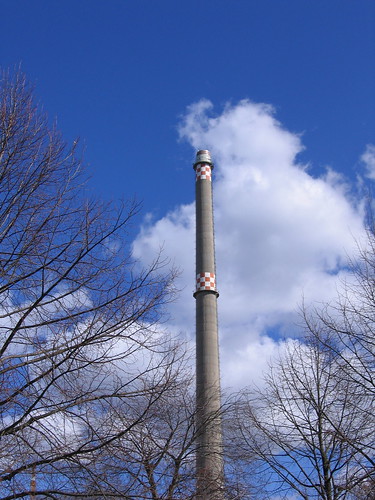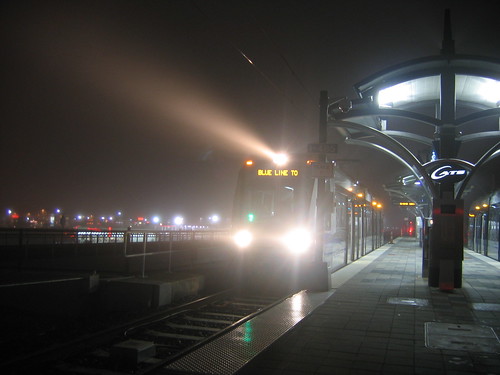Monday, November 30, 2009
Four O'Clock Factoid: A Boat You Can Get On
San Juan's Tren Urbano is the first rapid transit system in the Carribbean. Opening in December 2004, the line runs 10.7 miles to the south and west from old San Juan and has 16 stations. Trains come every 4 minutes, and Puerto Rico's Tren Urbano has an average daily ridership of 38,700.
Monday Shot: Blue Blur
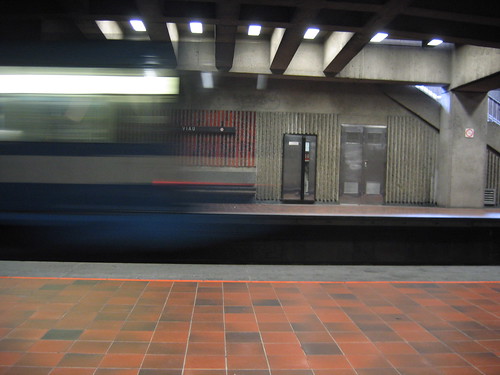
My photostream
Friday, November 27, 2009
Four O'Clock Factoid: Cantilevered
The longest cantilever span in the world spans the Saint Lawrence River near Charny, Quebec and is known as the Quebec Bridge. It is the most downstream crossing of the Saint Lawrence River and is owned by Canadian National Railway. It carries three lanes of auto traffic in addition to a pedestrian walkway. Via Rail Canada's Corridor trains traverse the bridge en route to Quebec City's Gare du Palais.
Metro brightens mezzanine at Judiciary Sq
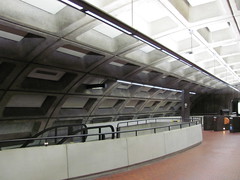 On November 24, Metro announced that they were testing new lighting at Judiciary Square's F Street Entrance. These new lights are designed to brighten the mezzanine, which has long been very dim. If the test is successful, the format will likely be expanded to other stations.
On November 24, Metro announced that they were testing new lighting at Judiciary Square's F Street Entrance. These new lights are designed to brighten the mezzanine, which has long been very dim. If the test is successful, the format will likely be expanded to other stations.Metro's original brutalist vaults were intended by their designer, Harry Weese, to be blank and to be lit entirely by indirect lighting. However, over the years, accoutrement has been added to the vaults, from station signs to security cameras. In most stations, supplemental lighting was added in mezzanines, which tend to be in perpetual shadow.
Fourth Street Entrance
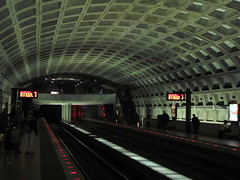
F Street Entrance
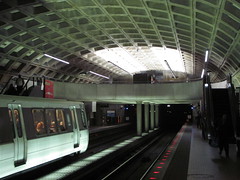
The new test lighting strikes a medium between the extremes. It adds lots of light to the mezzanines, while still providing light to the vault. At the same time, the fixtures' design limits the encroachment of the light supports on the vault.
All pictures in this post were taken by the author
Comments have been disabled. Please comment on this same post at Greater Greater Washington.
Photo Friday: Smokestack
Thursday, November 26, 2009
Four O'Clock Factoid: Disappearing Railroad Blues
Happy Thanksgiving!
Shortly after Amtrak began operations in 1971, the famous Illinois Central train The City of New Orleans was cancelled in favor of the overnight Panama Limited, which ran the same route. A 1972 song performed by Arlo Guthrie, The City of New Orleans, lamenting the disappearance of America's railroad heritage increased the popularity of the former Chicago-New Orleans train name, and in 1974, Amtrak restored the name "The City of New Orleans."
All the towns and people seem to fade into a bad dream,
and the steel rail still ain't heard the news.
The conductor sings his songs again, the passengers will please refrain.
This train's got the disappearing railroad blues.
Good night America, how are ya?
Say, don'tcha know me? I'm your native son!
I'm the train they call the City of New Orleans.
I'll be gone 500 miles when the day is done.
Wednesday, November 25, 2009
Four O'Clock Factoid: No Turns
The world's longest stretch of straight railroad track crosses Australia's Nullarbor plain. Across the flat desert, the track travels for just over 297 miles without so much as the slightest curve. It is traversed by the transcontinental train the Indian Pacific, which runs from Sydney to Perth and back twice a week.
Wednesday Wrap: 11/25
Happy Thanksgiving! Turkey day is tomorrow. In just a few hours, it'll be time for turkey and dressing, family and football. So stop reading this blog, and go help you mother with prep for the biggest meal of the year.
- The Armory Car: Newsweek looks at some of the implications of the legislative battle over guns on Amtrak. Republicans hope to force Amtrak to allow passengers to bring guns on board. Amtrak insists that this is a bad idea.
- The Orange Blossom Special Session: "She's the fastest train on the line" sings Johnny Cash. And it looks like Florida might just have a special legislative session to fund high-speed rail in the Sunshine State.
- Let's Cut Some Ribbons: An op-ed in The Hill encourages Washington to rethink infrastructure. We need to create jobs, and infrastructure is one way to do that, but we need to restrategize, say the writers.
- Windy City Express: South Bend fears it will get bypassed by Mid-West high-speed rail plans. They're calling for a solution that makes everyone happy.
- The Green Coast: A new study shows the savings from NJT's Hudson-Bergen light rail line. Maybe the "Gold Coast" should be renamed.
Tuesday, November 24, 2009
Four O'Clock Factoid: Master Builder
One of the most influential shapers of the urban form during the middle of the twentieth century was Robert Moses. His influence led to the construction of freeways across New York state and also helped lead to the demise of several transit lines in New York City. Many of the projects he championed are still integral parts of our transportation infrastructure, including the Triborough Bridge. In challenge to his critics, he charged: "if the ends don't justify the means, what does?"
Transit Tuesday: Airport Intermodal
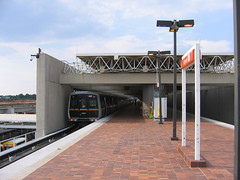
Thanksgiving is one of the busiest travel times of the year. Many people will be taking transit to the airport this week, so let’s take a look at airport-transit intermodal stations.
In 1968, Cleveland was the first American city to open a subway station directly inside an airport terminal. Passengers could board a Red Line train at Hopkins and ride downtown with one seat. Since then, many cities’ rail systems have been extended to the airport.
Cities with transit stations directly inside or adjacent to airport terminals are:
• Cleveland – Hopkins Airport, Red Line, 1968
• Washington – National Airport, Metro, 1977
• Atlanta – Hartsfield-Jackson Airport, MARTA, 1988
• Los Angeles – Bob Hope Airport, Metrolink/Amtrak, 1992
• Minneapolis – MSP Airport, Hiawatha Line, 2004
• Seattle – SeaTac Airport, Link, 2009 (UC)
• Providence – TF Green Airport, MBTA Commuter Rail, 2010 (UC)
Other cities have brought people mover systems from airports out to transit. Newark extended their airport people mover to a new station on the Northeast Corridor in 2001, where passengers can transfer to Amtrak and NJT Commuter Rail. Several cities have people mover connections between transit and airports in planning, including Dallas' Love Field and Phoenix's Sky Harbor Airport.
• Newark – Liberty Airport, AirTrain, 2001
Monday, November 23, 2009
Four O'Clock Factoid: Now That's Flying
The Shanghai Maglev Train is the world's first commerical application of a high-speed maglev line. Connecting Pudong International Airport to Metro Line 2, the train takes only 7 minutes 20 seconds to travel 30 kilometers (18.6mi). It travels at a top speed of 268 miles per hour briefly, and during testing reached a speed of 311 mph. An extension through southern Shanghai to Hongqiao Airport is in planning.
Monday Shot: Florida Sky
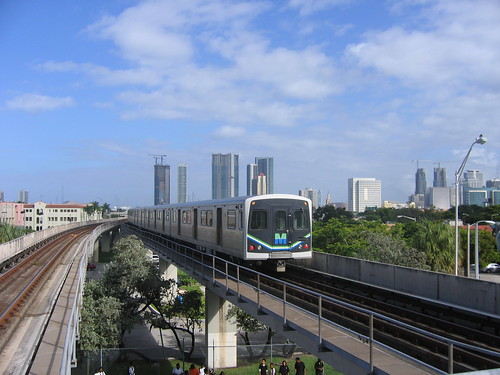
My photostream
Friday, November 20, 2009
Four O'Clock Factoid: Riding on One Rail
The Seattle Center Monorail connects downtown Seattle with the Seattle Center, home to the Space Needle. The line has one station at each end of the line: Westlake in the south and Seattle Center in the north. Over the years, various proposals to extend the line have been put forward. So far, none have come to fruition. The system was given landmark status in 2003.
Photo Friday: Parkway Lights
Thursday, November 19, 2009
Four O'Clock Factoid: Silver Streak
The wreck of the Federal Express, occurring on January 15, 1953 served as the inspiration for the 1976 movie Silver Streak. That day, the southbound Federal Express overshot the end of Track 16 at Washington's Union Station, crashed through the station master's office, and collapsed into the baggage room below the concourse (today's food court). The accident was caused when a design flaw on a New Haven Railroad car in the train's consist cut braking power to all cars except the locomotive.
Wednesday, November 18, 2009
Four O'Clock Factoid: The Big Hill
The Spiral Tunnels are a feat of engineering in the Canadian Rockies. Constructed from 1906-1909, they became an integral part of the Canadian transcontinental railroad. The tunnels allowed the CP Railway's grade to be reduced from an untenable and unsafe 4.5% to 2.2%. Trains still run through the tunnels, including the Kicking Horse route of the Rocky Mountaineer, so it's possible for passengers to ride through the tunnels (as I have done).
Wednesday Wrap: 'Complicit in your own Oppression'
- Reprogramming freeways: A New York Times op-ed looks at ways we can reuse freeways once driving on them isn't as big a deal.
- Bringing back the train: Jacksonville, Florida is seeking stimulus funding to get a transportation hub started. The second phase would bring passenger trains back to the old train station, which has since been converted to a convention center. It would be a big plus for riders, since the Skyway connects to the convention center and downtown.
- Transit co-operation: BART, which shares rail stations with Muni in downtown San Francisco is now releasing real-time info for Muni trains on its website.
- One-armed fare machines: Reno, Nevada is looking at constructing a streetcar line (later to be converted to LRT). The $67 million project would link downtown to the University of Reno campus. A second phase is also under consideration.
- Turbotrain Redux: Some 86% of Canadians support high speed rail and think all levels of government should be involved in getting it done.
- The Governator's Priority: California governor, Arnold Schwarzenegger, ordered state officials to drop all requests for rail stimulus funding except for the request for the California High Speed Rail program. Some are calling foul.
- Locos in the HOV Lane?: An Illinois company is leading the field in producing low-emission switcher locomotives. Since yards are often in urban areas and usually have the oldest engines in a railroad's fleet, significant health benefits could be realized.
- TSA Protecting Amcans: The TSA is now deploying personnel with bomb detection devices aboard Amtrak trains around the nation. Just as long as they don't have snow globe detectors, right?
- A Nice Paint Job: Minnesota's first commuter rail line, the Northstar, opened on Monday, and carried 2,400 riders. The trains have a very colorful paint scheme.
- Please Step Back to Allow Big Brother to Watch: The Obama Administration is planning to introduce new transit oversight legislation to Congress. Let's hope it doesn't kill transit off in the process.
- Splitting the Switch: Seattle's Link LRT is facing some criticism this morning after an out-of-service train split a switch at a rail yard disrupting service
yesterdayMonday. It's important to note that the train did not "derail", in fact, photos show that all the trucks stayed on the rails. But the final truck of the train did not diverge. This can still be an issue. The 1982 Washington Metro crash that killed three near Smithsonian was caused by splitting the switch. - Veronica Moss Returns: Hillarious A.U.T.O. lobbyist visits the newly reprogrammed Times Square, telling motorists that they should take the space back: 'you're complicit in your own oppression!'
What's the Most Crowded Part of Metro?
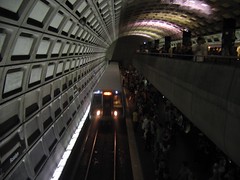 With an updated model of rider flows thanks to better data from WMATA, we can better understand crowding on Metrorail. Last week, We Love DC analyzed Metro crowding. They argued that Red Line riders have it worst because the Red Line carries 48% more riders than the Orange Line. However, the overall number of riders on the line as a whole is not enough to accurately measure congestion.
With an updated model of rider flows thanks to better data from WMATA, we can better understand crowding on Metrorail. Last week, We Love DC analyzed Metro crowding. They argued that Red Line riders have it worst because the Red Line carries 48% more riders than the Orange Line. However, the overall number of riders on the line as a whole is not enough to accurately measure congestion.The proportion of commuters in each direction matters as well. For instance, if we have two equivalent lines, each with the same ridership, and 90% of Line A's AM peak trips are inbound while only 60% of Line B's are, Line A will be more congested. It would still be more congested even if Line B had 10% more riders.
Another factor that must be considered is the spreading of trips along the line. Not every rider starts at a suburban terminal and rides to downtown. Some start at suburban terminals and ride to suburban office centers, while others start in urban neighborhoods and ride into or through downtown. The Red Line is the longest line and has more stations than the Orange Line, so more riders are to be expected.
Finally, the amount of rail service impacts congestion. The Red Line does not share trackage with any other rail line. This means that the number of trains per hour is higher on the Red Line than it is on the Orange Line, which shares tracks with the Blue Line.
With these factors in mind, let's look at rider volumes. The link with the most riders in the system, according to my analysis, is the inbound Blue/Orange shared segment between Rosslyn and Foggy Bottom, which carries 44,719 people between opening and 9:30 AM. In second place is the next link inbound, from Foggy Bottom to Farragut West, carrying 41,137 riders during that period. In third place comes the Red Line, with 31,773 trips from Dupont Circle to Farragut North. This means that the most used section of track of the Red Line carries only 70% as many riders as the busiest section of track on the Blue and Orange Lines.
But the real crux of the issue becomes clear at the Rosslyn junction point. At Rosslyn, 65% of inbound riders are on the Orange Line, but only 60% of trains are on the Orange Line. That means that passenger demand slightly outstrips the supply of railcars at that point. And the inbound track between Court House and Rosslyn is the 7th busiest in the system during the AM Peak.
Tuesday, November 17, 2009
Four O'Clock Factoid: Speer's Berlin
Welthauptstadt Germania was a plan to remake Berlin into the "world capital" of the Third Reich. To institute this ambitious plan, Hitler brought in Albert Speer. The plan included creating major public buildings and spaces. It also involved razing some areas of the city in order to make way for new monuments, axes, and circulation. Little of these plans were realized.
Metro Ridership Patterns Expanded
In July, I analyzed how people travel within the Metro system, using a survey to estimate riders' choice of alternate routes.
Because the data used was for average daily travel between origin and destination stations, it was not possible to determine which stations were primarily 'commute from' stations and which were primarily 'commute to' stations. However, after my July post, WMATA offered to give me time-specific data, which allows us to look at commuting patterns. The data used for this revised analysis looks at trips taking place between system opening and 9:30AM. The dataset comes from an averaging of AM Peaks from early May 2009.
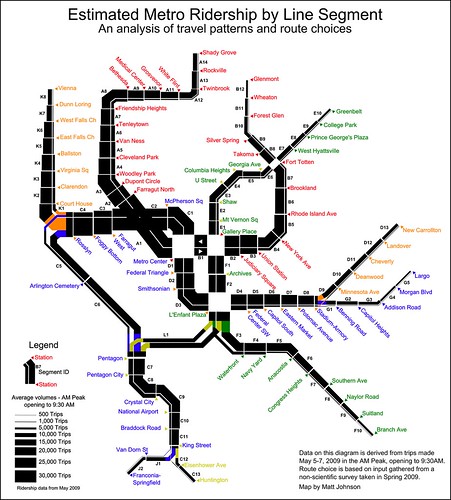
Read more ->
Note: Commenting has been disabled. Please continue the discussion at this same post on Greater Greater Washington.
Transit Tuesday: Taking the Trolley
Running 2.6 miles from Ashmont to Mattapan, south of Boston, the Mattapan High Speed Line acts as an extension of the Red Line subway. But it is unique in America as the last "native" operation of PCC Streetcars. I had the privilege to ride the line at Railvolution Boston a few weeks ago.
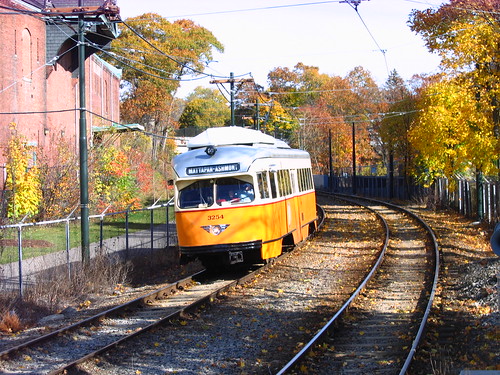
A car bound for Mattapan approaches Milton station
These streetcars are named after the "Presidents' Coordinating Committee" of the leaders of streetcar companies to save the streetcar from competition. Their 1929 endeavour created what is perhaps the most endearing symbol of transit in the inter-war and post-war era. The first PCC cars were delivered to Pittsburgh in 1936, and almost every American city operated the cars into the 1950s. Several cities continued to operate major fleets into the 1970s, when LRV conversion began in earnest.
The Mattapan Line opened in 1929 using an abandoned railroad route. Over time, streetcars became less and less prevalent in Boston and in the United States as lines were bustituted and abandoned. But the Mattapan line was retained. One reason that line rail was not converted to bus was because it used a private right-of-way. Similar situations kept lines in San Francisco, Pittsburgh, and other cities from being bustituted as well. While many PCC lines have been upgraded to modern LRV operation, including other lines in Boston, Mattapan's bridge weight limits have kept PCCs running out of Ashmont.
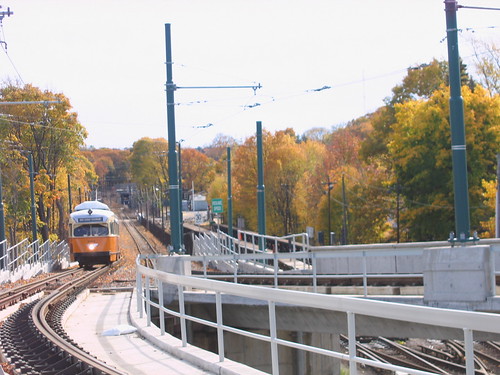
A PCC approaches the new terminal loop at Ashmont
While many cities have brought back PCC cars as touristy or heritage-type lines, Boston's Mattapan line is unique in that service has been more or less continuous except for a two-year closure for rebuilding from 2006-2008. Pittsburgh used PCC cars in regular service until 1999 and Newark suspended use of PCCs in 2001, leaving Boston's the last surviving continuous PCC operation.

A train at Central Avenue
The cars used on the Mattapan Line, therefore, are some of the oldest in revenue service in the United States, having been built between 1943 and 1946. Their recent rebuilding has put them in excellent shape, however. Trips on the train are smooth and quick. And for a railfan, quite thrilling, too.
The line's name is a bit misleading. Trains only travel at an average speed of around 20mph between Ashmont and Mattapan. However, the line has only two grade crossings, and as an extension of the Red Line, is effective. It makes the trip from Ashmont to Mattapan in only 9 minutes.
Monday, November 16, 2009
Four O'Clock Factoid: Trunk Colors
New York City's massive subway system uses letters and numbers to identify routes. But colors are important too: they indicate which Manhattan trunk line the route uses, with the exception of the IND Crosstown Line, which does not enter Manhattan, and shuttles, which are all colored dark gray. This color scheme has been in place since 1979 and was proposed by R. Raleigh D'Adamo in a contest held by the transit agency in 1964.
Monday Shot: Flying High
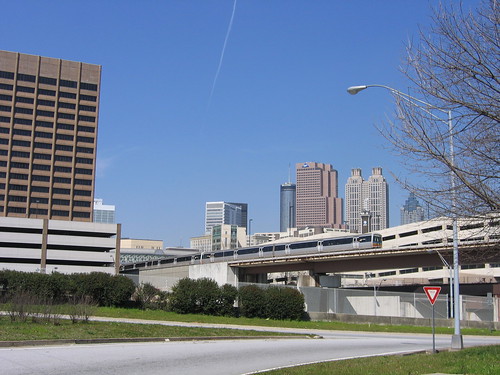
My photostream
Friday, November 13, 2009
Four O'Clock Factoid: Important Acts
The Carrollton Viaduct is the world's oldest still-operating railroad bridge. Located in Baltimore, Maryland, the stone masonry structure carries CSX trains over Gwynns Falls. It is named for Charles Carroll of Carrollton, who considered laying its cornerstone the second-most important act of his life, after only signing the Declaration of Independence. It was built by the Baltimore and Ohio Railroad and was opened in November 1829.
Photo Friday: Threading the Needle
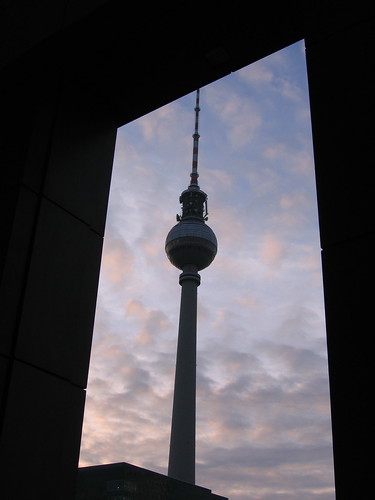
The sky really caught my eye in this shot of
Berlin's Fernsehturm, framed by an opening
My photostream
Thursday, November 12, 2009
Four O'Clock Factoid: Pioneering
The Amtrak Pioneer operated service between Seattle and Salt Lake City (later Denver) beginning in 1977. It was discontinued along with the Desert Wind in 1997, eliminating service to Wyoming and southern Idaho. Amtrak recently completed a feasibility study on reviving the Pioneer.
Wednesday, November 11, 2009
Four O'Clock Factoid: Providence Tunnel
Providence, Rhode Island's East Side Trolley Tunnel is a remnant of streetcars in the capital of the Ocean State. Built in 1914, it's been carrying buses since 1948 through a 2000-foot long bore under College Hill.
Wednesday Wrap: On the Blink
- Guns, Bullets, and Rail: Ryan Avent wonders what we could do with just one year of defense spending invested in infrastructure.
- On the left track with its left blinker on: Some Floridians are pushing for a special session of the state legislature to kickstart the SunRail project. The federal government has hinted that funding for high speed rail is contingent on the Sunshine State finding funding for SunRail and the existing TriRail.
- What's the point?: One wonders why they even bother with that little 'D' next to their names. Some Democrats are feeling a bit of anxiety over next year's legislative agenda. They would prefer not to face votes on Climate Change, Immigration Reform, or Gays in the Military. In fact, it seems the only things some want to deal with are jobs, jobs, and jobs. One representative uses a football analogy, saying we shouldn't be going for a Hail Hary when a first down will do. But we shouldn't punt on second down either.
- Blue screen of gridlock: In Montgomery County, Maryland, an affluent suburb of Washington, a computer (apparently installed when Jimmy Carter was wearing sweaters in the oval office) crashed and plunged the county into two days of gridlock. With the signals unable to talk to each other or adjust to rush hour timing, traffic lined up for miles. This incident just goes to show how fragile and vulnerable our transport network is.
- What's that smell?: A recent analysis by Forbes shows that Atlanta is America's most toxic city. Detroit, Chicago, Houston, and Philadelphia round out the top five.
- Another Maryland transit project: The Corridor Cities Transitway proposal in Montgomery County, Maryland is gaining steam as cost-benefit estimates look good.
- Pedestrian Accelerators: Walkscore has finally added transit stops as an attribute of their famous neighborhood walkability scoring matrix.
- The Separation of Church and Bus: A MARTA bus driver has been suspended for five days after refusing to let a passenger leave his Route 125 bus and insisting that passengers join hands while he led them in a prayer.
- The Bridge is Falling: In yet another example of decaying infrastructure, the Lake Champlain Bridge, built in 1929, which connects New York and Vermont, was closed October 16 after inspectors discovered it was facing imminent collapse. Drivers face a 90-mile detour for now.
- Internet Rides the (metro)Rails in Miami: Miami-Dade Transit is bringing WiFi to buses and metro trains as a part of a pilot project.
- Commuters and Diners: RTD, Denver's transit agency is going to "license" a part of the rail line they purchased for a northern commuter rail line to a historical society for free. The society will run excursion trains on the part of the line not being used for commuter service.
Tuesday, November 10, 2009
Four O'Clock Factoid: Greening Cities
The Garden City Movement was founded by Ebenezer Howard in 1898 in an effort to create self-contained cities with a balance of residences, industry, and agriculture surrounded by a greenbelt. In England, two cities were based directly on Howard's ideas: Letchworth Garden City and Welwyn Garden City. The movement also influenced the greenbelt cities movement of New Deal urbanism in the United States.
Transit Tuesday: Tipping the Balance
Colored lines seem to work in the places they've been implemented. They might not be best in all cases, however. As far as Atlanta is concerned, however, "Yellow" seems a bit clearer than North, Northeast, and South Lines (the Doraville-Airport train traversed all three). This was more of an issue on the East-West/Proctor Creek Line, since Proctor Creek trains only went as far east as King Memorial (later extended to Edgewood/Candler Park), but the blue line representing both did not make that fact clear.
But a system like New York's does not lend itself to colored designations very well. With 26 services, the rainbow just can't cope, and letters and numbers seem to suffice. Many European cities use similar numbering schemes. Paris, Berlin, and Munich come to mind, for instance.
In the US, Red seems to be the most common color. Six cities, Atlanta, Boston, Chicago, Cleveland, Los Angeles, and Washington all have Red Lines. Chicago tops the list with 8 colored lines: Red, Orange, Yellow, Green, Blue, Purple, Pink, and Brown.
Monday, November 9, 2009
Four O'Clock Factoid: Long Platforms
At 700 feet in length, San Francisco's BART has the longest subway platforms in the United States. Trains can actually be as long as 710 feet when configured as 10-car trains.
Monday Shot: Misty Night
Friday, November 6, 2009
Four O'Clock Factoid: First Subway
Boston's Tremont Street Subway is the oldest in the Western Hemisphere. Opened September 1, 1897, it's been carrying trains ever since. The two oldest underground transit stations in the United States are located along this stretch - Boylston and Park Street. Today, the tunnels carry Boston's Green Line. This subway is not a heavy rail subway, but is rather a light rail/streetcar subway. It predates underground operation in New York by 7 years.
Photo Friday: Trestle

My photostream
Thursday, November 5, 2009
Four O'Clock Factoid: 1916 Inspiration
New York's Hell Gate Bridge carries Amtrak's Northeast Corridor high above the East River. The 1,017 foot span served as the inspiration for Sydney's Harbor Bridge and carried four tracks when opened in 1916. Soaring high over Astoria, the bridge's approaches give passengers headed north of Penn Station breathtaking views of Manhattan's skyline and the Triborough Bridge. It was completed in just two and a half years at a cost of $20 million (approximately $390 million in 2008 dollars).
Lighting Changes to Prevent Suicides?
 The San Fransicso Chronicle is reporting that railway operators in Japan are installing blue LED lights at stations to deter suicides. While there is no scientific proof that the changes will stop someone bent on killing his or her self, the agencies note that blue lights do have a calming affect on people.
The San Fransicso Chronicle is reporting that railway operators in Japan are installing blue LED lights at stations to deter suicides. While there is no scientific proof that the changes will stop someone bent on killing his or her self, the agencies note that blue lights do have a calming affect on people.Of course that raises the question of Metro's recent decision to install red LED lights at the edge of platforms. Red is typically a color associated with aggression. WMATA installed the lights in an effort to encourage passengers to stay back from the platform edge.
H/T: The Transit Wire
Wednesday, November 4, 2009
Four O'Clock Factoid: Always Underground
The rubber-tired Montreal Metro is one of only a few subway systems to be entirely underground. Because the rubber tires can't cope with large amounts of snowfall, Montreal's climate restricts lines to subterranean tunnels.
Wednesday Wrap: Strikes and (Jay)walks
- Strike One: In the City of Brotherly Love, Transit Workers Union Local 234 began striking tuesday morning. Affected are most of Philadelphia's bus and streetcar routes and all subway and elevated services. Fortunately for Philadelphians, Regional Rail trains are still operating, although a Wednesday morning fire aboard a train cripled service on the R5 line.
- State Takeover: The commonwealth of Massachusetts has taken over transportation in the Bay State, including the MBTA. This move brings all of the transport agencies under one roof.
- Funding Safety Gap: A recently released study commissioned by Massachusetts Governor Deval Patrick reveals that due to funding shortages, critical safety issues have gone unaddressed at the MBTA, Boston's transit provider.
- Cincinnati Streetcar Hurdle Fails: A November 3 vote to amend the city charter so as to require a public vote to afirm city expenditures on rail transit failed. This means that transit projects will not have to jump through an extra hoop in Cincy.
- Up a Creek: The Amtrak Niantic River drawbridge along the Northeast Corridor in Connecticut got stuck down, trapping boats in the harbor on Monday. That's funny, because on Thursday, my train to Boston got delayed when the bridge wouldn't close.
- WiFi at 125 mph: Amtrak announced plans to introduce WiFi service on Acela trains by the second quarter of 2010.
- Buffet buys the Number 2: Warren Buffet has made a big wager on the future of transportation in the United States by buying BNSF Railway, the second largest American railroad for $34B.
- To WALK or to DONT WALK: Tom Vanderbilt on Monday penned a well-reasoned defense of jaywalking.
